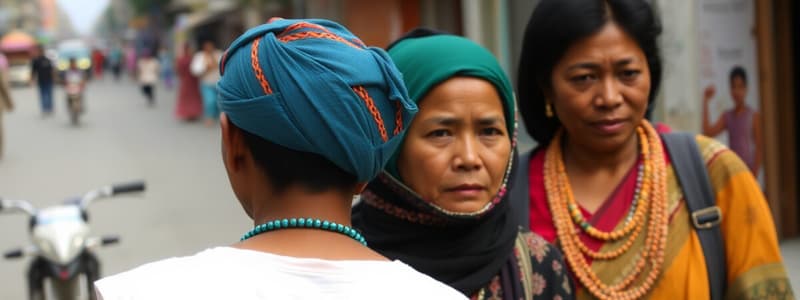Podcast
Questions and Answers
What is a primary challenge faced by Indigenous peoples in urban areas?
What is a primary challenge faced by Indigenous peoples in urban areas?
- Systemic discrimination (correct)
- Lack of cultural identity
- Overpopulation of healthcare facilities
- Abundance of employment opportunities
What common factor contributes to the migration of Indigenous communities to urban areas?
What common factor contributes to the migration of Indigenous communities to urban areas?
- Increased rural education facilities
- Political advocacy efforts
- Natural disasters exacerbated by climate change (correct)
- Enhanced agricultural opportunities
Which of the following describes a benefit of urban migration for Indigenous peoples?
Which of the following describes a benefit of urban migration for Indigenous peoples?
- Immediate economic stability
- Formation of social and cultural networks (correct)
- Easier access to rural plumbing infrastructures
- Reduced discrimination in rural regions
What is often lacking in urban policies that affects Indigenous populations?
What is often lacking in urban policies that affects Indigenous populations?
How do urban areas serve Indigenous peoples regarding political and legal advocacy?
How do urban areas serve Indigenous peoples regarding political and legal advocacy?
What impact did colonization have on Indigenous peoples regarding their ancestral lands?
What impact did colonization have on Indigenous peoples regarding their ancestral lands?
What is one of the main contemporary reasons for Indigenous migration to urban areas?
What is one of the main contemporary reasons for Indigenous migration to urban areas?
How does globalization contribute to Indigenous migration to urban areas?
How does globalization contribute to Indigenous migration to urban areas?
Which economic factor is a primary reason for Indigenous peoples migrating to urban areas?
Which economic factor is a primary reason for Indigenous peoples migrating to urban areas?
What historical event contributed to the forced displacement of Indigenous peoples?
What historical event contributed to the forced displacement of Indigenous peoples?
What role do development projects play in Indigenous migration?
What role do development projects play in Indigenous migration?
Why do many Indigenous peoples migrate to urban areas to access social services?
Why do many Indigenous peoples migrate to urban areas to access social services?
What is an effect of militarization and conflict on Indigenous migration patterns?
What is an effect of militarization and conflict on Indigenous migration patterns?
Flashcards
Colonization and Forced Displacement
Colonization and Forced Displacement
The act of taking Indigenous peoples' land and disrupting their traditional ways of life, often leading to forced relocation.
Development Projects
Development Projects
Large-scale projects like logging, mining, and agriculture that displace Indigenous peoples, forcing them to seek opportunities elsewhere.
Militarization and Conflict
Militarization and Conflict
Conflicts and violence in rural areas that push Indigenous people to seek safety and better opportunities in urban areas.
Pursuit of Employment
Pursuit of Employment
Signup and view all the flashcards
Access to Education and Health Services
Access to Education and Health Services
Signup and view all the flashcards
The trend of economic activity concentrating in urban centers, attracting people from rural areas, including Indigenous people, in search of better opportunities.
The trend of economic activity concentrating in urban centers, attracting people from rural areas, including Indigenous people, in search of better opportunities.
Signup and view all the flashcards
Healthcare and Social Services
Healthcare and Social Services
Signup and view all the flashcards
Marginalization and Discrimination in Urban Areas
Marginalization and Discrimination in Urban Areas
Signup and view all the flashcards
Forced Relocation and Environmental Issues
Forced Relocation and Environmental Issues
Signup and view all the flashcards
Government Policies and Urban Indigenous Populations
Government Policies and Urban Indigenous Populations
Signup and view all the flashcards
Cultural and Social Networks in Cities
Cultural and Social Networks in Cities
Signup and view all the flashcards
Political Activism in Urban Areas
Political Activism in Urban Areas
Signup and view all the flashcards
Study Notes
Indigenous Urban Migration: Historical and Contemporary Factors
- Indigenous migration to urban areas is a multifaceted phenomenon rooted in historical and contemporary factors.
- Historical factors include colonization, forced displacement, and development projects. Colonization led to the establishment of reserves in less fertile areas, restricting access to resources and opportunities. Development projects (e.g., logging, mining, agriculture) also displace Indigenous people, prompting urban migration for work. Militarized conflicts and violence in rural areas further drive people to urban areas for safety and better living conditions.
- Contemporary factors driving migration include economic opportunities, access to services, social networks and cultural connections, and political advocacy.
- Economic Factors: Urban areas usually offer better employment prospects than rural areas, addressing high unemployment rates among Indigenous populations. Increased access to education (high schools, colleges, universities, and training programs) and healthcare services is another key driver. Globalization and urbanization concentrate economic activity in urban areas and draw people, including Indigenous peoples, for better economic prospects.
- Social Factors: Urban areas have better healthcare facilities, social services, and community organizations, which are often lacking in remote Indigenous communities. Cities also offer large, diverse Indigenous populations, providing social and cultural networks for Indigenous peoples to maintain and celebrate their identities.
- Political Factors: Indigenous peoples face systemic discrimination in both rural and urban settings. Issues with housing, employment, and access to services due to historical inequalities and racial biases persist in urban areas. Contemporary issues such as climate change, militarization, and land dispossession continue to force indigenous communities into urban areas, driving migration trends. A lack of supportive government policies addressing unique needs of urban Indigenous populations can hinder their success in urban life. Urban areas often act as centers of political and legal advocacy, with indigenous organizations and social movements working toward Indigenous rights and political recognition. Migration to urban areas enables increased participation in social change and policy efforts.
Studying That Suits You
Use AI to generate personalized quizzes and flashcards to suit your learning preferences.



